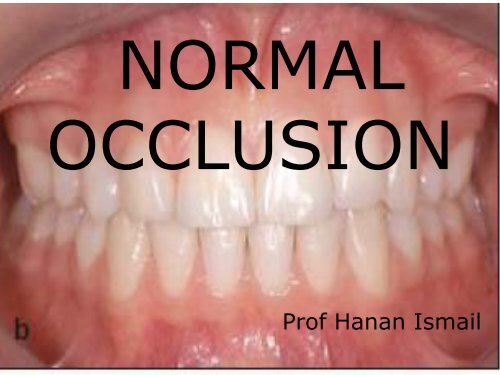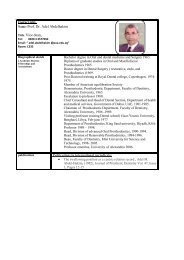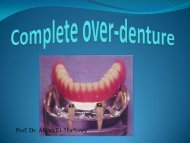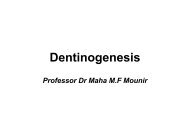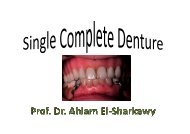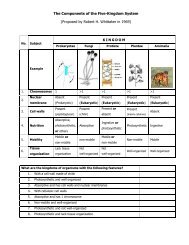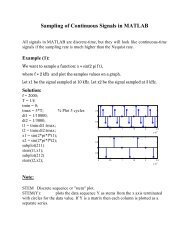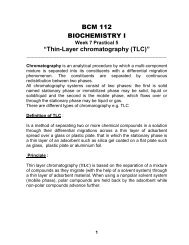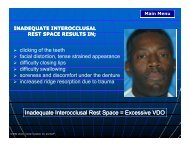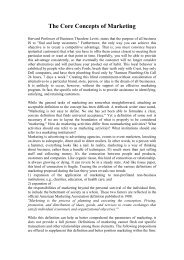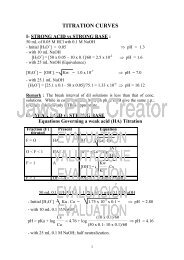You also want an ePaper? Increase the reach of your titles
YUMPU automatically turns print PDFs into web optimized ePapers that Google loves.
<strong>NORMAL</strong><br />
<strong>OCCLUSION</strong><br />
Prof Hanan Ismail
Normal versus ideal:<br />
In humans Normal implies variation around an<br />
average or a mean, therefore normal is always a range<br />
and never a fixed value, for example one cannot state a<br />
solid figure for normal men height, but it is accepted<br />
to say that normal height could be between 150 cm to<br />
190 cm for instance.
In addition normality changes with age<br />
therefore it is dynamic and indicates<br />
biological adaptability. For example<br />
presence of a diastema is normal during the<br />
ugly duckling stage but not in an adult<br />
occlusion.
An occlusion is considered to be normal when all<br />
the teeth are present and occlude in a healthy<br />
stable and pleasing manner.<br />
On the other hand ideal connotes a hypothetical<br />
concept rarely found in clinical practice
DEFINITION<br />
Dictionary definition: Occlusion by<br />
dictionary definition refers to the act<br />
of closure or being closed.<br />
•
ANGLE DEFINITION<br />
The normal relation of the occlusal<br />
inclined planes of the teeth when the jaws<br />
are closed. (According to Dr. Angle, normal<br />
occlusion exists when the mesiobuccal<br />
cusp of the upper first molar occludes with<br />
the buccal groove of the lower first molar).
MODERN DEFINITION<br />
Dental occlusion is the static and<br />
dynamic inter-relationships of the<br />
opposing surfaces of the maxillary and<br />
mandibular teeth that occurs during<br />
movements of the mandible and when<br />
the maxillary and mandibular dental<br />
arches are in terminal approximation.
FEATURES OF <strong>NORMAL</strong> ADULT <strong>OCCLUSION</strong><br />
1-The arch form varies from a parabolic to a<br />
horse-shoe shape. Lower arch is U shaped.<br />
2-The maxillary arch occupies a greater arch<br />
of a circle than the mandibular arch hence,<br />
overbite and overjet exist between the<br />
upper and lower teeth.
3-The permanent upper central incisor occludes<br />
on its palatal aspect with the incisal edge of the<br />
lower central and the mesial half of the incisal<br />
edge of the lower lateral incisor, so each tooth<br />
occludes with its opposing number and the tooth<br />
distal to it ,with the exeption of the upper third<br />
molars which occludes with the distal twothirds of<br />
the lower molars.<br />
Both arches have a common midline.
4-The triangular ridge of the mesiobuccal<br />
cusp of the maxillary first molar occludes in<br />
the mesiobuccal groove of the mandibular<br />
first molar. Class I molars and<br />
Canines occlude in class I, mesial slope of<br />
the upper canine cusp occludes with the<br />
distal slope of the lower canine.
5-Both dental arches have a common<br />
occlusal plane with maximum<br />
intercuspation during closure.
ORGANIZATION OF <strong>OCCLUSION</strong><br />
There are three concepts that describe the<br />
manner in which teeth should and should not<br />
contact in various functional and excursive<br />
positions of the mandible:<br />
1- Balanced occlusion<br />
2-Group function occlusion<br />
3- Canine guidance occlusion<br />
Both 2 and 3 are nonbalanced occlusions
BALANCED <strong>OCCLUSION</strong><br />
WHEN FUNCTIONAL AND NON -<br />
FUNCTIONAL SIDES CONTACT<br />
SIMULTANEOUSLY IN EXCURSIVE<br />
MOVEMENTS
SUITABLE FOR<br />
COMPLETE DENTURES<br />
Balanced Dentures are<br />
less likely to be<br />
dislodged<br />
causing Denture Sores
NOT SUITABLE FOR NATURAL<br />
DENTITIONS<br />
BALANCED NATURAL DENTITIONS<br />
ARE LIKELY TO CAUSE HEADACHES<br />
AND TEMPOROMANDIBLAR JOINT<br />
PROBLEMS
NONE BALANCED <strong>OCCLUSION</strong><br />
Called(functional=organic=physiologic=<br />
mutually protected) and is found in natural<br />
teeth and fixed prosthodontics. Where<br />
during protrusive movement there is an<br />
incisal guidance that disengages posterior<br />
teeth, and during lateral movement there<br />
is a canine or group guidance that<br />
disengages the teeth on the non working<br />
side.
WHAT IS A MUTUALLY PROTECTED <strong>OCCLUSION</strong>?<br />
Treatment should go beyond just straightening the<br />
front teeth, but should establish an ideal bite,<br />
which protects the teeth, muscles and joints. A<br />
mutually protected occlusion includes :<br />
1-A lower jaw that is comfortably seated in the<br />
joint.<br />
2-There is even simultaneous contact of the back<br />
teeth and light contact of the front teeth during<br />
max intercuspation.<br />
3-There should also be anterior guidance, cuspid<br />
disclussion, and the elimination of balancing side<br />
interferences to maintain good health of the teeth,
Lawrence Andrews discussed six significant<br />
characteristics of normal occlusion which he<br />
observed in a study of 120 casts of<br />
nonorthodontic patients with normal<br />
occlusion.<br />
Andrews noted that the lack of one of the six<br />
characteristics[which he called the keys to<br />
normal occlusion]was an indication of<br />
incomplete end result in treated models.
THE SIX KEYS TO <strong>NORMAL</strong> <strong>OCCLUSION</strong>:<br />
(Significant characteristics of normal occlusion)<br />
1-MOLAR RELATION:<br />
a.The distal surface of the distobuccal cusp of<br />
the first permanent molar contact and<br />
occluded with the mesial surface of the<br />
mesiobuccal cusp of the lower second molar.
.The mesiobuccal cusp of the upper first<br />
permanent molar fell within the groove<br />
between the mesial and middle cusps of<br />
the lower first permanent molar.<br />
c.The mesiolingual cusp of the maxillary<br />
first molar was seated in the central<br />
fossa of the mandibular first molar.
2.Crown Angulation(mesiodistal tip):<br />
This term refers to the long axis of the<br />
crown not the long axis of the entire<br />
tooth.<br />
In normal occlusion the gingival<br />
portion of the long axis of the crown<br />
was distal to the incisal portion<br />
varying with the individual tooth<br />
type.
The degree of crown tip is the angle between the<br />
long axis of the crown as viewed from the buccal<br />
or labial surface and a line bearing 90 degrees<br />
from the occlusal plane.<br />
A +ve reading is given when the gingival portion of<br />
the long axis of the crown is distal to the incisal<br />
portion. A –ve reading is given when the gingival<br />
portion is mesial to the incisal portion.
Normal occlusion is dependent upon the<br />
proper distal crown tip especially the<br />
upper anterior teeth, since they have the<br />
longest crowns. Let us consider that a<br />
rectangle occupies a wider space when<br />
tipped than when upright.Thus, the<br />
degree of tip of the incisors determines<br />
the amount of mesiodistal space they<br />
occupy and has a considerable effect on<br />
posterior occlusion as well as anterior<br />
esthetics.
3-CROWN INCLINATION (Torque):<br />
The crown inclination is the faciolingual<br />
torque of the long axis of the crown. It is the<br />
angle formed between the facial long axis of<br />
the crown and a perpendicular line erected<br />
from the occlusal plane.
It is +ve when the gingival portion<br />
of the long axis of the crown is<br />
lingual to the incisal portion and<br />
vice versa.<br />
In normal occlusion it is negative<br />
for all the teeth except the<br />
maxillary central and lateral<br />
incisors.
Upper and lower anterior crown<br />
inclination affect overbite and<br />
posterior occlusion. Properly inclined<br />
anterior crowns contribute to normal<br />
overbite and posterior occlusion.<br />
When too straight they lose their<br />
functional harmony and over-eruption<br />
results.
When the upper anterior crowns are<br />
insufficiently inclined , the upper posterior<br />
crowns become forward to their position or<br />
spaces open between posterior and<br />
anterior teeth.<br />
When the anterior crowns are properly<br />
inclined the posterior teeth are encouraged<br />
into their normal position.
4-ROTATIONS:<br />
In normal occlusion the<br />
teeth should be free of<br />
undesirable rotations.
5-TIGHT CONTACT:<br />
In normal occlusion contact<br />
points should be tight.
6-OCCLUSAL PLANE:<br />
It is the imaginary plane on which<br />
teeth meet in occlusion. In normal<br />
occlusion it should be flat or nearly flat.<br />
Intercupationis best when the plane<br />
of occlusion is relatively flat.
A deep curve of spee results in a more<br />
contained area of the upper teeth making<br />
normal occlusion impossible (only upper<br />
first premolers are properly intercuspated,<br />
the remaining upper teeth anteriorly and<br />
posteriorly are in error).<br />
A reverse curve of spee is an extreme form<br />
of treatment allowing excessive space for<br />
each tooth to be intercuspally placed.
LECTURE REFERENCE<br />
Text book of Orthodontics<br />
Second edition<br />
G.Singh<br />
Jaypee<br />
Lecture Reference:<br />
Peter E. Dawson. Evaluation,<br />
Diagnosis, and Treatment of<br />
Occlusal Problems, 2nd ed.. Mosby.
THANK YOU


